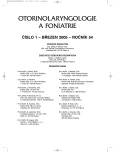Bleeding after Tonsillectomy
Krvácení po tozilektomii
Souhrn:
Na klinice ušní, nosní, krční FN Hradec Králové jsme retrospektivně zpracovali dokumentaci pacientů, kteří podstoupili tonzilektomii v letech 1992–2001. Soubor tvoří 1492 pacientů, z toho 841 žen a 651 mužů. Věkový průměr pacientů byl 22 let, medián 19 let.
Všechny operace ve sledovaném období byly provedeny klasickou extrakapsulární technikou se stavěním peroperačního krvácení bipolární elektrokoagulací či ligaturou. Průměrná doba hospitalizace po operaci byla pět dnů.
Významné krvácení, tj. krvácení, které si vyžádalo lokální ošetření, jsme zaznamenali u 49 (3,3 %) pacientů, z toho časné krvácení do 24 hod. od výkonu bylo pozorováno u 20 (1,3 %) a pozdní u 29 (1,9 %) pacientů. Drobné krvácení nevyžadující lékařské ošetření bylo zaznamenáno u dalších 140 pacientů, z toho časné u 93 (6,2 %) a pozdní u 47 (3,2 %) pacientů.
Autoři sledovali vliv následujících faktorů na krvácení po tonzilektomii:
věk pacienta, pohlaví, vliv operační techniky, operatéra, peritonzilární absces v anamnéze, ponechání rezidua tonzilární tkáně v lůžku, vliv pooperační akutní infekce a vliv ročního období.
Studie prokázala statisticky významně častější pooperační krvácení u dospělých pacientů ve srovnání s dětmi mladšími 15 let (p=0,0015), častější časné krvácení u pacientů operovaných v lokální anestezii (p=0,0005), častější časné krvácení při použití kličky k uskřinutí dolního pólu tonzily (p = 0,018), častější pozdní krvácení u pacientů operovaných pro peritonzilární absces „a froid“ (p = 0,003) a častější krvácení při ponechání rezidua tonzilární tkáně (p=0,004). Vliv ostatních sledovaných faktorů na pooperační krvácení byl statisticky nevýznamný.
Zpracování rizikových faktorů může být jedním z hledisek pro rozhodování o délce hospitalizace pacientů po tonzilektomii.
Klíčová slova:
tonzilektomie, krvácení, operační technika.
Authors:
L. Školoudík; Z. Dufek; J. Vokurka; P. Čelakovský
Authors‘ workplace:
Klinika ušní, nosní, krční LF UK a FN, Hradec Králové
přednosta doc. MUDr. J. Vokurka, CSc.
Published in:
Otorinolaryngol Foniatr, 54, 2005, No. 1, pp. 42-46.
Category:
Original Article
Overview
Summary:
The authors performed a retrospective analysis of documentation for patient who had undergone tonsillectomy at the Ear, Nose and Cervix Clinic in Hradec Králové during 1992–2001. The cohort consisted of 1492 patients, 841 of them being women and 651 men. The mean age of the patients was 22 years, median 19 years.
All operations in the period of observation were performed by the classical extracapsular technique with stopping preoperation bleeding by bipolar electrocoagulation or ligature. The mean period of hospitalization was five days.
A significant bleeding, i.e. bleeding which required a local treatment, was detected in 49 (3.3%) patients, early bleeding up to 24 hours being observed in 20 (1.3%) patients and late bleeding in 29 (1.9%) patients. A minute bleeding which did not require medical care was detected in other 140 patients, early bleeding being inn 93 (6.2%) and late bleeding in 47 (3.2%) patients.
The authors followed the influence of the following factors on bleeding after tonsillectomy:
age of the patient, sex, effect of surgical technique, surgeon, peritonsillar abscess in anamnesis, left tonsillar tissue in the bed, effect of postoperation acute infection and the effect of the time period of the year.
The study demonstrated a statistically significantly more frequent peroperation bleeding in adult patients as compared with children younger than 15 years (p=0.0005), more frequent early bleeding in patients operated on in local anesthesia (p=0.0005), more frequent early bleeding with the use of a loop for incarceration of the lower pole of tonsil (0.018), more frequent late bleeding in patients operated on peritonsillar abscess “a froid” (0.003) and more frequent bleeding when a residuum of tonsillar tissue was left (p=0.004). Effects of othger observed factors on postoperation bleeding were statistically insignificant. The processing of the risk factors may be used in decision making concerning the duration of hospitalization of patients after tonsillectomy.
Key words:
tonsillectomy, bleeding, operation technique.
Labels
Audiology Paediatric ENT ENT (Otorhinolaryngology)Article was published in
Otorhinolaryngology and Phoniatrics

2005 Issue 1
Most read in this issue
- Relapsing Middle Cervical Cyst and Atypical Position of Hyoid Bone
- Central Hearing Loss in Children with Developmental Dysphasia
- Testing Olfaction Merkers by Means of Perfumed
- Present Classification of Laser Cordectomy
